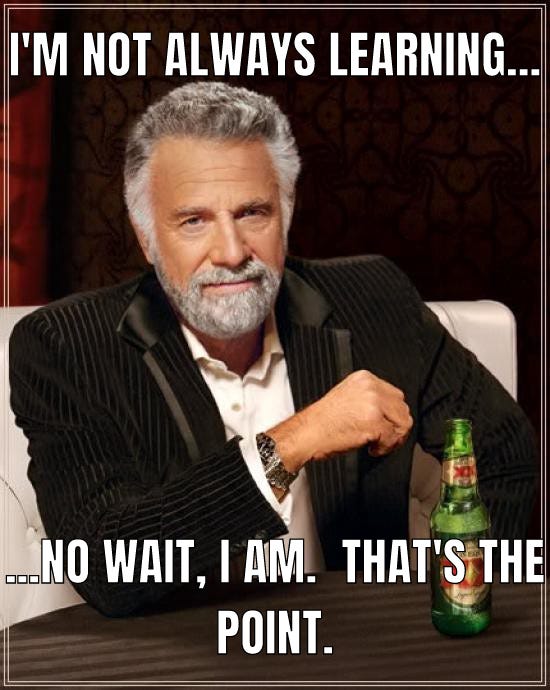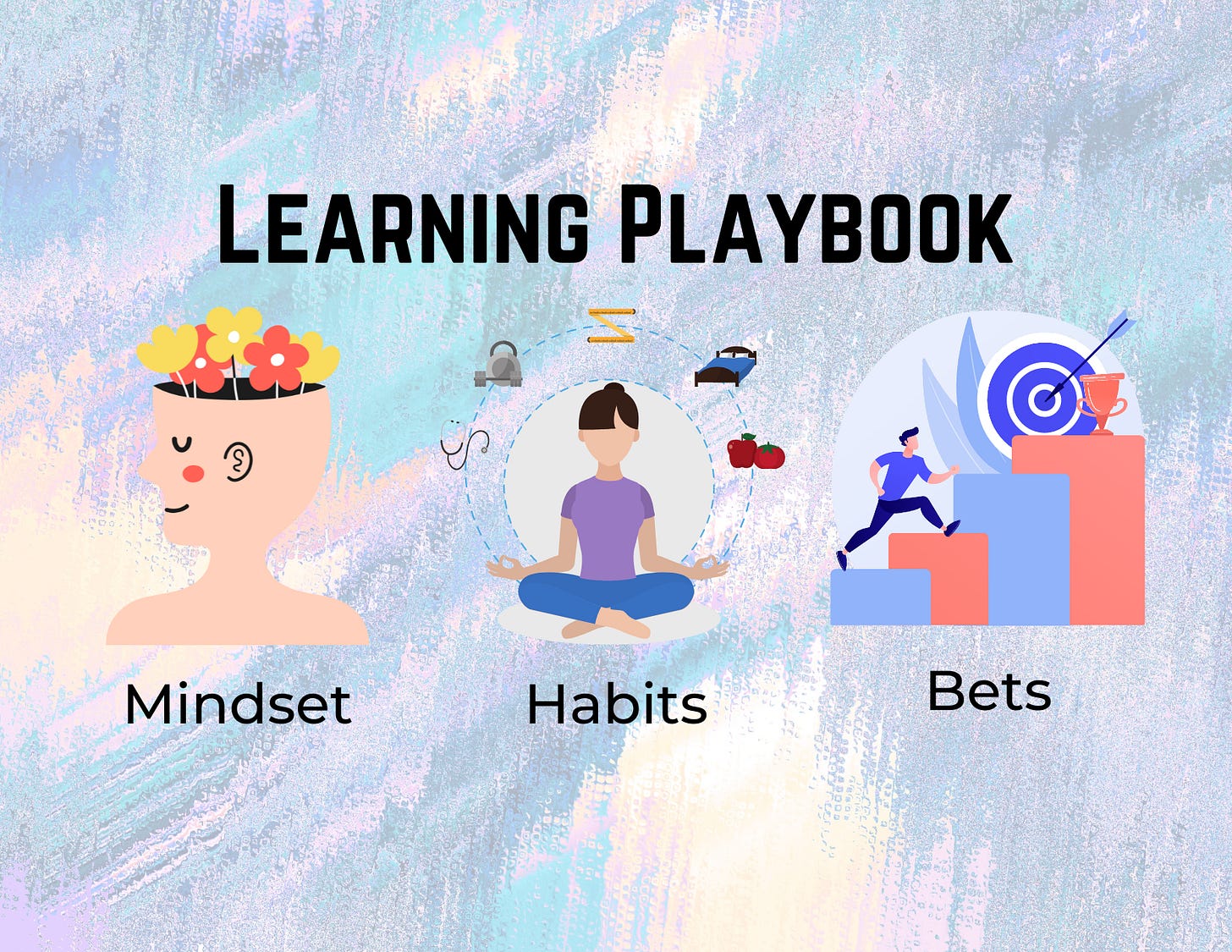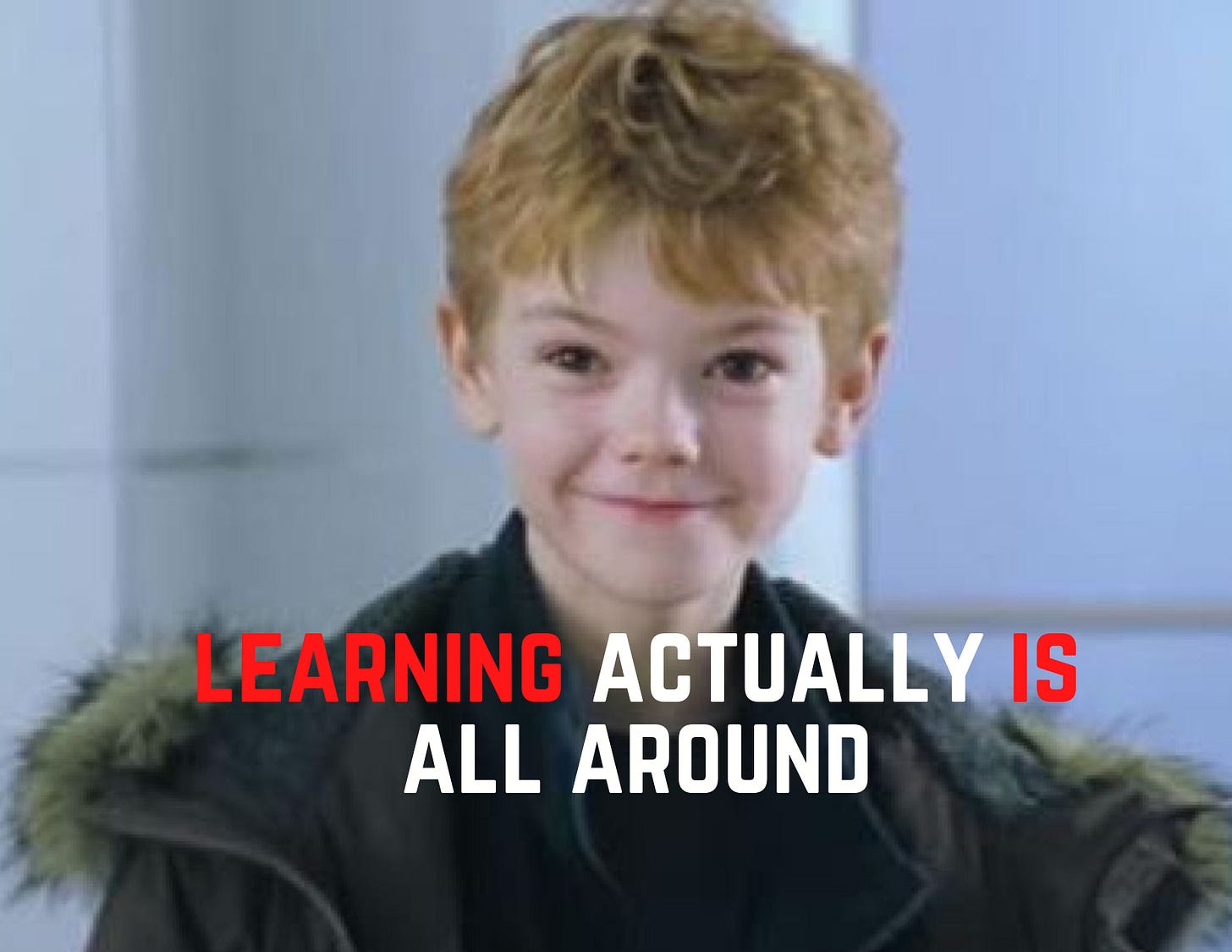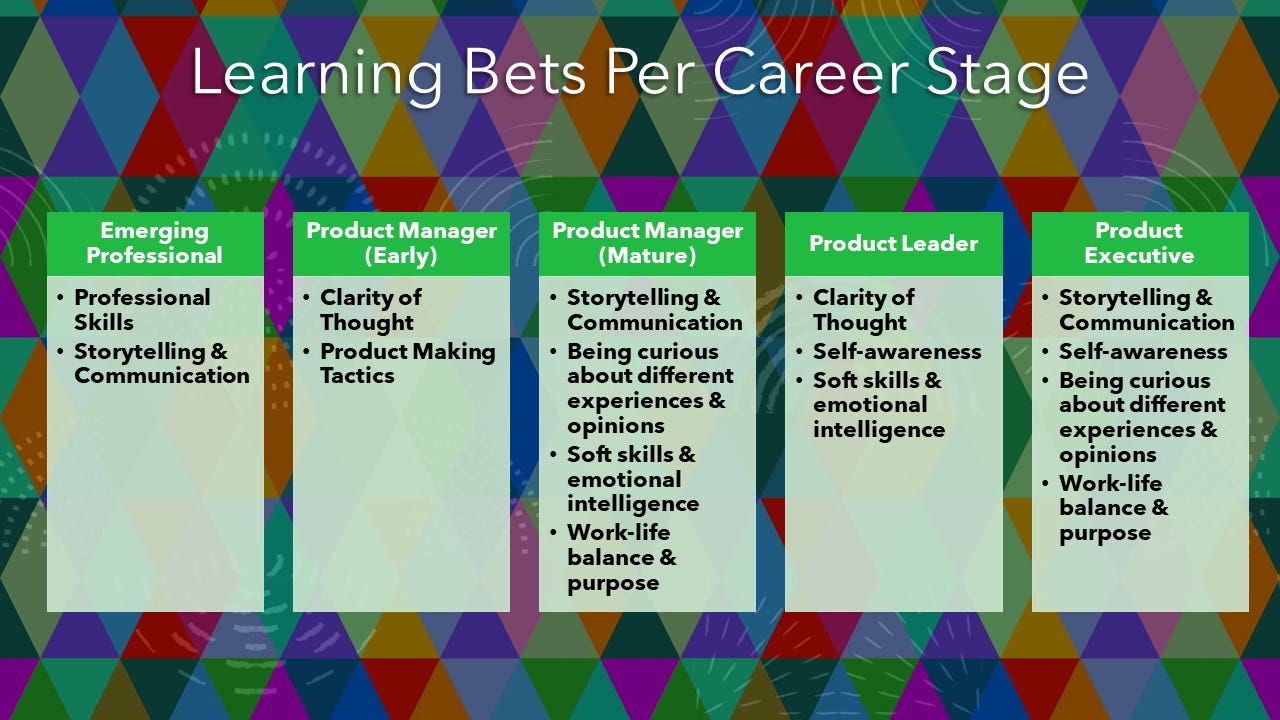🔦 How You Can Find Learning Opportunities Everywhere
Top 10 areas for product management learning & a framework to incorporate into your routines.
“Hey Adam, how do you think about incorporating learning into your job? What forms of learning are most effective for product jobs? Give me a playbook!”
As the leadership team sponsor for learning and development in my org, I’ve been curious about how to activate a culture of learning within an organization. One thing that’s been clear to me is that people get overwhelmed by the choices and find it difficult to balance their own development with other demands of the job. Without clear expectations and a menu of choices, it’s easy for learning to be deprioritized.
Read on if you want concrete, practical advice on how to incorporate learning into your routines. 2023 New Year’s Resolution anyone? 🥳
The Biggest Unlock: Redefine Learning
Q: What percentage of time should I be spending on learning and development?
A: 80%!
Ya, that’s not a typo. Forget the framing where you only carve out 10% of your time for training courses. Even if you do defy the odds and find the time for this separate activity, you’ll carry with you grief that it didn’t really fill up the learning cup anyway.
Instead, you have to define learning broadly and incorporate it into your daily routines. You have to evolve your job such that you get paid to learn. It’s the only way.
Product Management Learning Areas: The Menu
The first step on this journey is to redefine learning away from just improving the tactics of your job. Feedback, introspection, news and information consumption, discovering the needs of your colleagues with different perspectives - it’s all learning.
Throughout my 17 years as a PM, my learning needs have evolved depending on my role and the businesses I was in. Summing them all together, here are the top 10 areas I’ve focused my learning and development on:
Professional Skills. Time management, how to make high-integrity commitments & trust building.
Storytelling & Communication. Writing, presentation (internal and external), and clarity of message skills.
Clarity of Thought. Strategic insights, pattern matching options, reducing the search space of potential solutions. This is a “pre-req” to great storytelling.
Product Making Tactics. The core skills of growth hacking, product discovery, scaling products, tradeoff analysis, risk reduction, and go-to-market playbooks.
Industry & Market Trends. Awareness of the industry, what’s going on in tech, and synthesizing to best practices what industry players are doing.
Self-awareness. Time spent getting perspectives from colleagues and practicing self-analysis.
Being curious about different experiences & opinions. DEI & learning go hand in hand. Reading a book written by an author from a different background is absolutely job and skill development. So is practicing the art of learning to understand before being understood.
Soft skills & emotional intelligence. Leadership training, personality quizzes, influencing without authority.
Customer, competitor, data, and hands-on with the product. This category is the best example of “getting paid to learn” and includes the time I spend using my own product, filing bugs, and wallowing in data analysis of my product. I’ll also include checking out new apps/competitors, attending a readout from user research, and customer visits.
Work-life balance & purpose. Exploring my purpose, how to cultivate outside hobbies alongside my passion at work, and how to take great time off. These are skills and time spent getting better at them is learning, too. Here’s a shift in thinking: These are probably more important to your happiness than learning a new growth hacking skill.
It’s intentional of me to intermix my core product skills, news and info consumption, feedback collection, and personal awareness & purpose alignment together into one list. You should get comfortable that all of it is intermixing together into a learning plan for your work life.
The Learning Trifecta: Mindset, Habits, Bets
If you are with me so far, you have now redefined learning to be broader than whether your company pays for Reforge or not this quarter (but it should do that too, it’s an awesome treasure trove of hard product skills). That still doesn’t answer how to incorporate all this learning into your life.
Here’s a simple framework that enables you to take action. Think about your learning across three different cups to fill up: Mindset shifts, Habits formed, and Bets chosen.
🧠 Mindset Shift
Build the muscle such that, on the margin, you choose to be curious more often than you push your agenda. It’s how you get to 80% of your time spent learning.
It’ll make you a better product manager and team member. I say this despite (or because of) the fact that so many of our jobs are about pushing an agenda. Yes, we are doers at heart, but you’ll stand out if your default behavior is to pause and reflect.
Fans of Grit and the Coaching Habit will recognize this behavior. The goal is to prioritize learning and seek it out in everyday moments. It’s Growth Mindset.
How do you know you are successful with the mindset shift? Well, to paraphrase a cheezy 1990’s Christmas romantic comedy, it’s when you feel like learning, actually, is all around.
Making this mindset shift is hard work and takes practice and grace. Here are three ideas you can try:
Learning Cohorts. We’ve launched a program called Pick 3 Learning Cohorts in our org recently. The tagline for the program is “Deploy Your Curiosity.” People are paired into groups of 6-8 and meet weekly to share 3 moments of learning in their work week. The goal is to practice a growth mindset and hold ourselves accountable for prioritizing moments of learning. It’s learning how to learn. If you work for Microsoft, you can check out the internal SharePoint site for the program.
Learning Kanban Boards. A manager on my team has a Kanban board where each team member keeps a list of things they want to learn. When they check something off, it’s a celebratory moment for the team. They keep it top of mind by looking at it in team meetings.
Mood Boards. If personal reflection is more your jam than social accountability, try creating a mood board that clarifies how you want to show up at work. Check out one that I did last May.
🔁 Habits Formed
Some learning is less about dedicated skill growth and more about incorporating it like a drip-drip-drip into your life every day. Instead of binge-watching Netflix, do you choose the podcast on PM skills? Do you have the rhythms in place to keep updated on the industry? Do you have the habit of returning to customer data frequently?
This can be overwhelming, so let me break it down. Of the top 10 areas of product learning, these 4 lend themselves to habits:
Industry & Market Trends. Podcasts, books, and newsletters are your friend. Here’s my take on the best ones. If you want to incorporate these into your routines, check out Atomic Habits.
Self-awareness. Use the feedback process for your organization and augment it with one-off 1:1’s where you remember to ask “What feedback do you have for me?” at least once a quarter. Seek out your biggest critics - they are secretly a gift. Don’t be afraid to look higher in the organization - I regret not feeling comfortable asking senior leaders for feedback earlier in my career.
Being curious about different experiences & opinions. I have two ways I form habits here. First is to pause and reflect before entering a big meeting. I think of the most curious person I know and ask “How would they show up to this meeting?” Second, I combine Diversity & Inclusion curiosity with my fiction consumption, prioritizing female and racial minority authors with different experiences than myself. I seek out the way they created a different story and environment than I would have and what I can learn from that.
Customer, competitor, data, and hands-on with the product. As a Product Manager, it’s your job to establish a team rhythm around customers & data. This is a great chance to help those around you develop habits and express total ownership of product. I’ve also used my calendar time wisely here in the past - for instance, booking off Monday morning for dedicated time for me to wallow in dashboards.
Ok, self-analysis time. Analyze your own habits around these 4 areas. Considering focusing on one where you can improve.
📈 Bets chosen
If you really want to fill up your learning cup, your background mindset and habits will go a long way. However, in my experience, choosing one or two focus areas to surge on fulfills me and helps me thrive.
Examples
Here are a few examples of “learning bets” that I’ve surged on in my past career:
Taking a course on emotional intelligence and using it to work a stuck relationship.
Planning and attending a “Design & Donuts” learning seminar to focus on improving my knowledge and empathy for design at a time when the company was betting on the discipline.
Working with a professional leadership coach who interviewed those around me and we co-created an action plan to take my leadership presence to the next level.
Often these bets are time bound, combine structured learning with practical application, and feel urgent to my life.
How many?
It’s OK if you have zero “learning bets” and just rely for a while on habits and routines. Having one bet is ideal - give yourself the space to go deep. Having two is OK too if you have a strong need to grow or extra time on your hands. Three or more is crazy and I would not recommend it.
How to choose?
Learning bet choice comes down to three questions:
What is the skill growth most common for your career stage right now?
What does the urgent and immediate business context require from you in the next six months? Ask around, especially to org leaders, about where org gaps are - do we need to empower design? Learn about emerging tech like AI?
What does your gut tell you would be interesting to you? Learning is a creative process & passion is key. What moves you?
Let me expand on question #1 and share my thoughts on the type of learning bets you are likely to want to prioritize per career stage.
Career stage & common learning bets
I remember vividly taking some training on storytelling as a brand new Senior PM at Microsoft. I remember thinking “Wow, how lucky am I to have taken this training at the exact time I could use this in my career!” In hindsight, I need to buy a beer for the L&D Program Lead who knew exactly the most common skill development needs per career stage.
From my post on product careers, here is my framework for the evolving career of a product manager:
Here are my thoughts on the types of learning bets most likely to be useful per stage:
Emerging Professional (APM, PM, PM II): If you are just starting your career, focus on nailing the fundamentals of post-college life - professional skills, storytelling, and communications. This is the foundation that you’ll build depth & specialization on later and it’s still useful even if you change careers away from product management.
Product Manager (Early (PM II, Senior PM)): Congrats, you are proficient at the art of thriving in a business environment. Time to go deep on product tactics and clarity of thought. The heart of a product job. These will help you get 10x faster at your job the quickest.
Product Manager (Mature) (Senior PM): You are now 10x faster at your job and need to prepare to solve more complex problems. Return to some fundamentals like communication & storytelling skills through this lens of greater difficulty. Pivoting to soft skills and curiosity can help you start to build coalitions. This is a great time to examine your own sense of self and get off auto-pilot on work/life balance, too.
Product Leader (Principal PM): Welcome to leadership and massive ambiguity. You are in the fishbowl - people are watching you - so clarity of thought and self-awareness tend to be focus areas.
Product Executive (Partner, Director, VP): Since the job is about creating environments, self-awareness, your own sense of purpose, clarity of thought, and storytelling are paramount. You are also a role model for DEI and prioritizing curiosity even more so than average is key.
Putting This Into Practice
In short:
Form a learning cohort to change your mindset towards finding learning moments everywhere.
Analyze yourself on the 4 habits of product learning and chose one habit to focus on.
Pick 1 learning bet based upon your career stage, business context, and what give you passion.
That’s my advice. This will encourage the right balance between formal training, on-the-job learning, retrospectives, and news and info consumption.
Give yourself some grace as you start putting this into practice - learning should be fun and keep you in the Flow; it shouldn’t be a burden. Good luck and please reach out if something in this post sparked your curiosity. I love talking to readers and love talking about learning and habits!











Really excellent read and of course I agree 🙌
Great distillation of ideas on the art of learning!